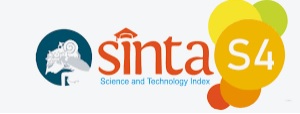Sistem Informasi Geografis Untuk UMKM Kuliner Pada Kelurahan Tanah Sereal
Abstract
The Micro, Small and Medium-scale Enterprises (MSMEs) sector in Indonesia, especially in the city of Jakarta, is a key pillar for increasing income and creating jobs. MSMEs, including culinary businesses, stand out due to their affordable start-up capital and huge profit potential. To be successful in the culinary business, it is important to have an understanding of the market, a well-thought-out strategy plan, and choose the right location. Geographic Information Systems (GIS) play an important role in assisting aspiring culinary MSME entrepreneurs in choosing a suitable location and promoting their business in a useful way. This research adopts the Agile Scrum method with stages ranging from product backlog, sprint backlog, sprint, sprint review, to sprint retrospective. The GIS was designed using programming languages such as PHP, HTML, CSS, and the Laravel framework with the addition of a database. The results showed that the development of this GIS aims to provide assistance to the community in obtaining information about the location of Culinary MSMEs in Tanah Sereal Village. This system is designed so that it can be accessed and used easily by various parties. The conclusion of the research emphasizes the importance of developing GIS with suggestions for expanding regional coverage, adding MSME categories, improving the interface (UI), and adding features that make it easier for users. Thus, the implementation of GIS on culinary MSMEs in Jakarta City is expected to make a positive contribution to local economic development, create jobs, and provide easy access to information to the community.
Keywords: MSMEs, Geographic Information System; Culinary; Scrum
Â
Abstrak
Bidang usaha skala Mikro, Kecil, dan Menengah (UMKM) di Indonesia, terutama di Kota Jakarta, menjadi pilar utama untuk meningkatkan pendapatan dan menciptakan lapangan kerja. UMKM, termasuk bisnis kuliner, menonjol karena modal awal yang terjangkau dan potensi keuntungan yang besar. Untuk meraih kesuksesan dalam bisnis kuliner, penting memiliki pemahaman pasar, rencana strategi yang matang, dan memilih lokasi yang tepat. Sistem Informasi Geografis (SIG) berperan penting dalam membantu calon pengusaha UMKM kuliner dalam memilih lokasi yang sesuai serta mempromosikan usaha mereka secara berguna. Penelitian ini mengadopsi metode Agile Scrum dengan tahapan mulai dari product backlog, sprint backlog, sprint, sprint review, hingga sprint retrospective. SIG dirancang menggunakan bahasa pemrograman seperti PHP, HTML, CSS, dan framework Laravel dengan penambahan database. Hasil penelitian menunjukkan bahwa pengembangan SIG ini bertujuan untuk memberikan bantuan kepada masyarakat dalam memperoleh informasi mengenai lokasi UMKM Kuliner di Kelurahan Tanah Sereal. Sistem ini dirancang agar dapat diakses dan digunakan dengan mudah oleh berbagai pihak. Kesimpulan dari penelitian menekankan pentingnya pengembangan SIG dengan saran-saran perluasan cakupan daerah, penambahan kategori UMKM, peningkatan tampilan antarmuka (UI), dan penambahan fitur-fitur yang mempermudah pengguna. Dengan demikian, implementasi SIG pada UMKM kuliner di Kota Jakarta diharapkan dapat memberikan kontribusi positif dalam pengembangan ekonomi lokal, menciptakan lapangan kerja, dan memberikan kemudahan akses informasi kepada masyarakat.
Â
Keywords
References
C. Noviyanti, W. Erawati, and H. Lesmana, “Rancang Bangun Pemetaan UMKM Kota Tegal Berbasis Sistem Informasi Geografis,†Indonesian Journal on Software Engineering (IJSE), vol. 6, no. 1, pp. 56–63, Jun. 2020, doi: 10.31294/ijse.v6i1.8101.
B. A. Abdullah, “Sistem Informasi Geografis Sebaran UMKM Di Kota Cimahi,†Seminar Nasional Teknologi Informasi dan Multimedia, vol. 2, no. 3, pp. 74-82, Jul. 2018.
N. Azizah and N. A. Widiastuti, “IMPLEMENTASI SISTEM INFORMASI GEOGRAFIS PENCARIAN LOKASI UMKM DI KABUPATEN JEPARA,†Jurnal Informatika dan Rekayasa Perangkat Lunak, vol. 1, no. 1, pp. 56-61, 2019, doi: 10.36499/jinrpl.v1i1.2768.
M. D. Husni Santoso, I. Jamaludin, and E. D. Sri Mulyani, “Sistem Informasi Geografis Penyebaran Usaha Mikro Kecil Menengah (UMKM) di Kabupaten Majalengka,†Jurnal Teknologi Informasi dan Ilmu Komputer, vol. 7, no. 5 ,pp. 1029-1034, 2020, doi: 10.25126/jtiik.2020752489.
E. N. Anugrah and A. S. Karim, “Sistem Informasi Geografis UMKM Berbasis Website (Study Kasus Dinas Pariwisata Lampung Tengah),†JURNAL TEKNIKA, vol. 16, No.2, pp. 92-101, 2022.
S. Aprudi and M. Murahman, “Sistem Informasi Geografis Pemetaan Umkm Di Kota Lubuklinggau Berbasis Web,†INTECOMS: Journal of Information Technology and Computer Science, vol. 5, no. 2, pp. 180-185, 2022, doi: 10.31539/intecoms.v5i2.4888.
A. Andipradana and K. Dwi Hartomo, “Rancang Bangun Aplikasi Penjualan Online Berbasis Web Menggunakan Metode Scrum,†Jurnal Algoritma, vol. 18, no. 1, pp. 161-172, 2021, doi: 10.33364/algoritma/v.18-1.869.
T. S. Nugraha, K. Kusnadi, and R. Hardian, “Rancang Bangun Sistem Informasi Company Profile dengan Menggunakan Metode Scrum pada PT. Hasna Satya Negara Berbasis Web,†Jurnal Ilmiah Intech : Information Technology Journal of UMUS, vol. 3, no. 02, pp. 171-179, 2021, doi: 10.46772/intech.v3i02.583.
W. Aliman, “Perancangan Perangkat Lunak untuk Menggambar Diagram Berbasis Android,†Syntax Literate ; Jurnal Ilmiah Indonesia, vol. 6, no. 6, pp. 3092-3098, 2021, doi: 10.36418/syntax-literate.v6i6.1404.
T. A. Kurniawan, “Pemodelan Use Case (UML): Evaluasi Terhadap beberapa Kesalahan dalam Praktik,†Jurnal Teknologi Informasi dan Ilmu Komputer, vol. 5, no. 1, pp. 77-86, 2018, doi: 10.25126/jtiik.201851610.
A. A. Matekaa, Moh. R. A. Kalukub, N. Pakayac, and Abd. A. Boutyd, “SISTEM INFORMASI PEMETAAN PANTI ASUHAN KOTA GORONTALO,†Jurnal Ilmiah Teknologi Informasi dan …, vol. 2, no. 1, pp. 84-91, 2022.
E. R. Subhiyakto, Y. P. Astuti, and L. Umaroh, “Perancangan User Interface Aplikasi Pemodelan Perangkat Lunak Menggunakan Metode User Centered Design,†KONSTELASI: Konvergensi Teknologi dan Sistem Informasi, vol. 1, no. 1, pp. 103-110, 2021, doi: 10.24002/konstelasi.v1i1.4266.
E. Fernando, “Sistem Informasi Geografis Untuk Pemetaan Tempat Kesehatan Di Kota Jambi,†Teknik Informatika, pp. 79-87, 2012, doi: 10.13140/RG.2.1.1476.0405.
I. R. Munthe, E. W. Wardana, and G. J. Yanris, “RANCANG BANGUN SISTEM INFORMASI GEOGRAFIS PEMETAAN HUTAN PADA KABUPATEN LABUHAN-BATU,†Rabit : Jurnal Teknologi dan Sistem Informasi Univrab, vol. 6, no. 2, pp. 77-82, 2021, doi: 10.36341/rabit.v6i2.1717.
R. M. Widagdo and A. W. Utami, “Rancang Bangun Sistem Informasi Pemasaran (SIP) Business Intelligence Berbasis WEB-GIS pada PT.SPINDO Tbk,†Journal of Emerging Information System and Business Intelligence (JEISBI), vol. 3, no. 4, pp. 133-140, 2022.
How To Cite This :
Refbacks
- There are currently no refbacks.











